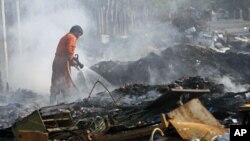The rising cost of floods in Asia is forcing governments to increase spending on water management plans aimed at preventing future disasters. Thailand says it is trying to prevent a repeat of last year's disastrous flooding.
Thai Prime Minister Yingluck Shinawatra said she is confident her government can prevent a repeat of the 2011 flood disaster by spending $11.5 billion to develop new water-resource management systems.
She predicted the Thai economy will grow by five percent this year, boosted in part by government spending on water management infrastructure.
The country’s most severe floods in decades claimed 700 lives and cost the economy $45 billion, while growth in 2011 plunged to 1.5 percent.
Urban communities were inundated and almost 14 million people were affected across dozens of provinces. The Philippines, Cambodia and Vietnam also were hit by flooding during the monsoon.
U.N. International Strategy for Disaster Risk Reduction Special Representative Margareta Wahlstrom said rising costs from flooding is a major challenge in Asia.
“The bigger challenge for many countries is how do you cope with the economic losses? Is it possible to change the economic infrastructure of a country? Can you move industrial areas off the coastline so they are less vulnerable? These are major, major issues that should be dealt with at the highest political level in order to protect the gains of countries,” said Wahlstrom.
A recent U.N. report says disasters, largely earthquakes and floods last year cost a record $366 billion and claimed the lives of more than 29,700 people.
Global Network of Civil Society Organizations for Disaster Reduction Chairman Marcus Oxley said economic development has added to the cost of disasters.
“Losses in terms of assets are actually on an exponential increase. The mortality losses due to floods and cyclones are actually decreasing. But the economic losses, the losses to livelihoods, the losses to houses, to our assets, our physical infrastructure is actually increasing,” said Oxley.
Since 1998 China has boosted spending on water management systems to reduce flood impact. But China’s rapid growth and urbanization has left more communities vulnerable to floods.
In recent years China has built 85,000 dams, 270,000 kilometers of dykes and 170 water-retention areas, as well as 31,000 flood gates to better cope with flood risk.
The joint secretary of India’s National Disaster Management Authority, Amit Jah, said governments have an increased responsibility to develop disaster risk-management systems, given Asia’s role as a driver of global growth.
“Asia is the engine of growth. Today the growth in the world and therefore a lot of activities associated with growth, like emerging consumption, land use, building of infrastructure is taking place in India as well as all over Asia," said Jah. "I can say that in India we are very much consumed with the whole idea of making our infrastructure disaster resilient, in making our response better to every disaster.”
He said the Indian government has taken disaster-risk reduction into all government departments linked with growth, as well as bringing in the private sector and civil society.
Asian Nations Spending to Reduce Costs of Disastrous Floods
- By Ron Corben







